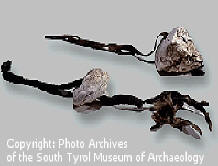Facts
Piptoporus betulinus was one of two polypore specimens found with the remains of a mummified human known as the "Iceman." Iceman was discovered by hikers in the Italian Alps in September 1991. Initially his remains were thought to be a lost hiker who succumbed to the elements. Then carbon dating was performed and the 5300 year old mummy was treated with rehydrating gels and refrigeration which slowed decomposition. Now Iceman is well preserved in a state of the art facility specially designed with two viewing chambers, an examination chamber, and an attached museum; complete with replica's of the Iceman and his belongings.
 Photo
taken near Otzi find site
Photo
taken near Otzi find site
Included in these belongings were two pieces of Piptoporus betulinus and a large amount of Fomes fomentarius. It is believed that Iceman used the Piptoporus as a medicine to remedy Trichuris michiura which is a nematode that pathologically manifested itself as extreme abdominal pain and bouts of anemia. The exact chemical responsible seems to be up for debate with new technology, however, agaric acid is suspected of being responsible for antiviral and antimicrobial action that may have aided in the alleviation of pain. Alleviation in the form of massive diarrhea that would "flush out" a large amount of the Trichuris michiura.
Also included amongst Iceman's possessions was a girdle bag full of a Fomes fomentarius which was used to start or transport fires. Piptoporus betulinus also works well as a fire starter while Fomes fomentarius is actually the better of the two. Fomes fomentarius is a hard, wood conk that needs to be moistened prior to pounding which then separates the hyphae which can then be used for its flammability capabilities. Another use for this fungi is weaving it into thread and making clothing.
Now Otzi is now in an artificial glacier at the South Tyrol Museum of Archaeology. A state of the art facility was created with two viewing chambers, in case one were to fail, and an examination chamber. Preserving Otzi is a constant challenge due to the natural bacteria waiting to consume the remains. The temperature and humidity are monitored continuously and set to a frigid -6 degrees Celsius- that's roughly 21.2 degrees Fahrenheit with a 98% relative humidity.
 South
Tyrol Museum of Archaeology
South
Tyrol Museum of Archaeology
Back to Reproduction
Click here to see the Interactions!!



